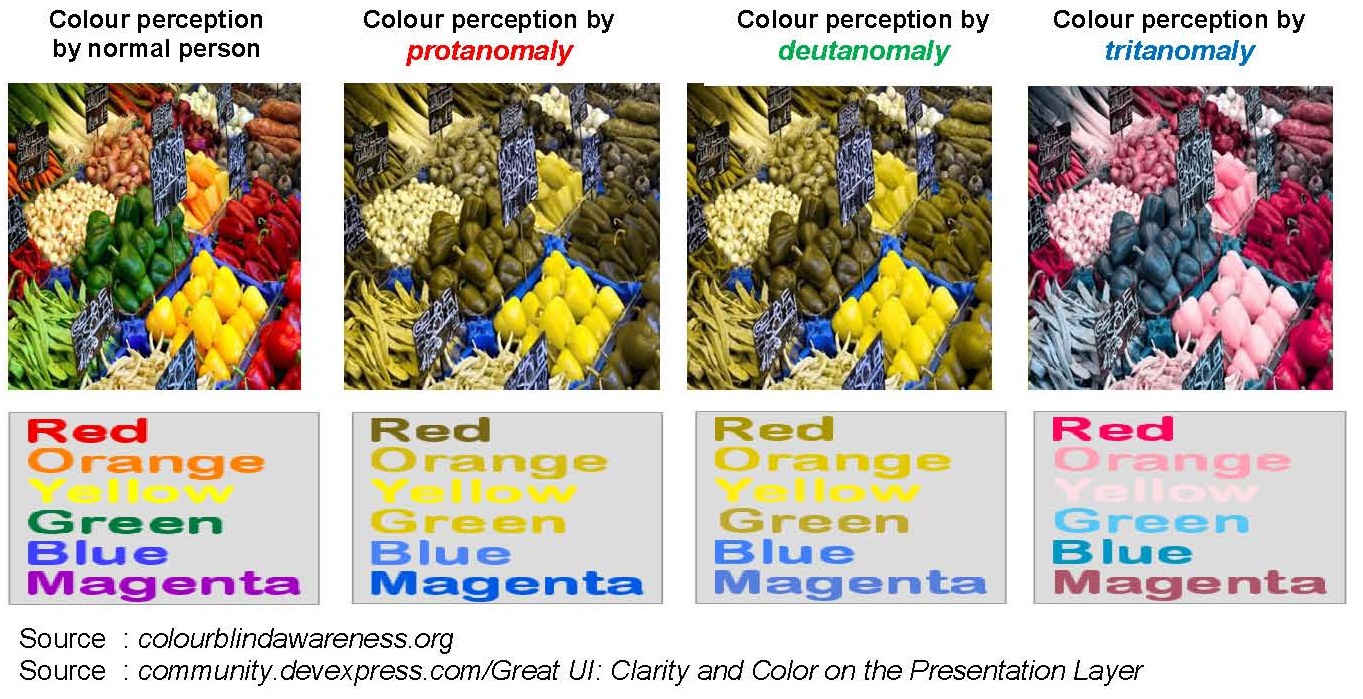Introduction
What will come across in your mind when we talk about colour vision deficiency? Many of us will imagine their life always in black and white.
In fact, this kind of perception is definitely wrong. People with colour vision deficiency still can recognize colours but their level of perceptions is different from normal person. They have difficulty in identifying colours between bright and dark colours and their severity ranging from mild to severe.
Causes of Colour Vision Deficiency
- Congenital/ since birth
- In most cases, colour vision deficiency is usually an inherited condition. It means that the indication is genetically passed from parents to their children.
- The type and severity of colour vision deficiency varies among individuals.
- The most common form of congenital defect is red and green deficiency.
- Men have higher risk of colour vision deficiency, with around 5% to 10% compared to women.

- Acquired
- Caused by illness or pre-existing health conditions such as diabetes, age related macular degeneration (ARMD), glaucoma, cataract and also injuries to the eyes.
- Side effects of some medications such as drugs for Rheumatoid Arthritis and Tuberculosis (TB).
Types of Colour Vision Deficiency
Generally there are three types:
- Monochromat (total colour vision deficiency)
- Person with total colour vision deficiency only perceive black, grey and white tones due to completely absence of tones.
- Very rare and the most severe form of colour vision deficiency.

- Dichromat
This is the moderate severity defect which caused by absence of one of the three cone systems:
- Absence of red cone pigment (protanopia) means that they cannot perceive red colour.
- Absence of green cone pigment (deutanopia) means that they cannot perceive green colour.
- Loss of blue cone pigment (tritanopia) means that they cannot perceive blue colour.
- Anomalous Trichromat
• The most common type of colour vision deficiency.
• Able to appreciate colours but generally mix up with the colour hues, due to:
• Abnormality of the red cone pigment (protanomaly)
• Abnormality of the green cone pigment (deuteranomaly)
• Abnormality of the blue cone pigment (tritanomaly)
This is the stimulation example that a person who has anomalous trichromat perceive:

How to Detect Colour Vision Deficiency
- Those children who have family history of colour vision deficiency should undergo colour vision examinations.
- These examinations can be done as soon as the children know different shapes and can understand instruction given.
- There are many tests available to diagnose colour vision deficiency such as D-15, 100 Hues, HRR, Anomaloscope and Ishihara colour plates. These tests will be carried out by an optometrist.
Treatment
- Currently, there is no medication to cure inherited colour vision deficiency.

- To date, the only treatment for colour vision deficiency is ChromaGen, which can be used to enhance the colour perceptions.
- However, ChromaGen depends on the severity of the colour defect. For severe defect that cannot be treated, a consultation will be given by the examiner.
- ChromaGen is an optical device, consists of contact lenses and glasses with colour filters that facilitates to enhance colour perceptions and ability to distinguish colours better.
- At present, Hospital Ampang is the only general hospital that provides ChromaGen treatment.
- However, ChromaGen only works for some people, depends on their severity of colour defect
- For acquired colour defect, it can revert to normal condition if completely recovered from the disease, provided there is no damage involving the cone cells.
Conclusion
Early detection since young children is vital in order to overcome the limitations. We should not treat colour vision deficiency people as disabled because they only have difficulty to distinguish colours. Despite of colour vision deficiency, many of them have normal visual acuity.
People with colour vision deficiency usually not having any learning problem because colour defect does not affect their IQ. They only need some guidance in order to choose the right profession in the future.
Do you know that Mark Zuckerberg, the founder of social site Facebook, is actually having colour vision deficiency? That is why he uses blue and white colours for the Facebook’s background.
According to Zuckerberg in the Time’s interview, he is unable to appreciate many colours including red and green. He only can perceive blue colour.
There are a lot of people who have colour vision deficiency and they live as normal people, the only difference is the way they perceive colours.
References
- Haliza AM, Md Muziman Syah MMS, Norliza MF.2010. Visual problems of new Malaysian drivers. Malaysian Family Physician.5(2):95-8)
- Phoon KYI, Chang WT, 2013, Practical assessment of colour vision to certify fitness of driving, SFP2013; 39(1) Supplement: 63-66
- http://www.nhs.uk/Conditions/Colour-vision-deficiency/Pages/Treatment.aspx
- http://www.aoa.org/patients-and-public/eye-and-vision-problems/glossary-of-eye-and-vision-conditions/color-deficiency#2
- http://courses.washington.edu/psy333/lecture_pdfs/Week7_Day2.pdf
- http://www.color-blindness.com/2008/03/29/improving-color-vision-with-lenses-for-the-colorblind/
- http://colorvisiontesting.com/color2.htm
- http://ghr.nlm.nih.gov/condition/color-vision-deficiency
- http://www.ireadbetternow.com/color-blindness-solution
- http://www.colourblindawareness.org/colour-blindness
- http://www.jpj.gov.my
| Last Review | : | 04 November 2014 |
| Writer | : | Pn. Hasyimah bt. Hamdan |
| Accreditor | : | Pn. Che Ruhani bt. Che Jaafar |







